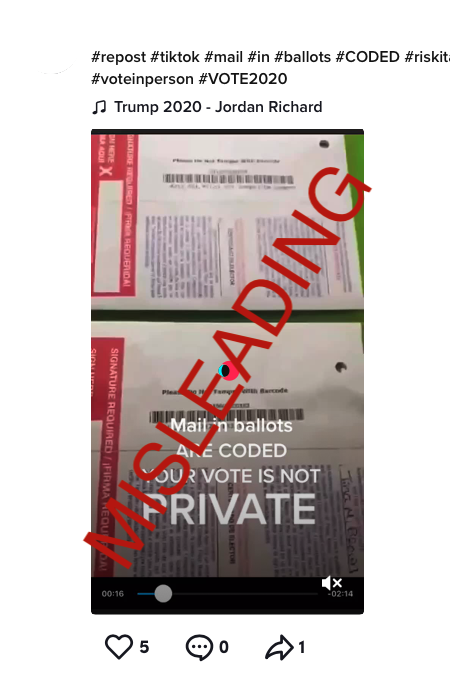Remove, Label, Ignore
Platforms’ Responses to Viral Misinfo About Mail-in Ballots Vary
Author: Daniel Bush
Researchers: Jack Cable, Tara Kheradpir, Ana Sofia Nicholls, Emily Ross, Chase Small
This blog post was updated on Sept. 29, 2020 to reflect actions taken by YouTube after the original publication date.
On Sept. 3, EIP analysts came across a Facebook post from mid-August containing misleading claims about mail-in ballots. Showing viewers two ballots that have arrived at her address, the video’s author indicates that the ballots’ barcodes contain information identifying the party affiliations of the voters they have been sent to and claims that this will allow malicious USPS workers to identify mail-in ballots likely to be for “the other party” and throw them out. But as a number of fact-checking outlets have established, the video shows ballots for Florida’s closed primary, held on Aug. 18, and the author’s implication that these are general-election ballots, or that general-election ballots will be identical to these, is false. As the Ohio Secretary of State explained in a tweet debunking the Facebook post, closed primaries are restricted to registered party members, so party-affiliation information is sometimes included in the barcodes for mail-in ballots to help election officials keep the party primaries distinct. General-election ballots will not include this information.
Despite the numerous fact checks since the video’s initial spread mid-August, the EIP has seen this narrative flare up repeatedly. Additionally, the analyst team observed the content’s most recent spread from Facebook, Twitter and YouTube to TikTok, where it gained significant traction before the platform took action.
An example of this content from mid-August which got over 110K views on Twitter. The EIP reported this content to the Twitter team and it has since been taken down.
After an initial spread on Facebook, Twitter and YouTube the content migrated to TikTok as well. TikTok content received over 100K views before removal.
This video belongs to the type of content that the EIP refers to as “procedural interference,” since it misleads viewers about actual voting procedures — in this case, the procedures related to voting by mail that allow voters to have confidence that their vote will be secret, namely a ballot cover free of party affiliation. (Like much election-related misinformation, it also contains elements of EIP’s other categories, since it could also have the effect of deterring viewers from participating and delegitimizing election results without grounds.) By falsely implying that these procedures are inadequate, this video could impact voters’ behavior and ability to participate in the election. At time of writing, this video had over 175,000 views, had been shared more than 5,000 times, and had received 542 comments; it had also become the basis of numerous other misleading posts on Twitter, TikTok, and YouTube, racking up many thousands of views and retweets as it spread.
As we outline in our summary of platform policies, the platforms mentioned above have policies that allow them to take necessary action against content of this type. We list them here, alongside the actions each platform took in this case:
As of Sept. 29, 2020, the responses from the platforms have varied greatly. YouTube applied labels with information about voting by mail to two posts containing the original Facebook poster’s video but did not label a third. TikTok and Twitter, on the other hand, removed most posts containing the video — Twitter left one tweet containing the video up, for some reason — but took no action against purely textual versions of the original claim. Facebook, taking the middle path, labeled the original video with the text “Missing Context. Independent fact-checkers say this information could mislead people” and links to fact-checking sites. It is worth noting that EIP also found a bug related to this label which prevented it from appearing in Facebook’s theater mode and alerted the platform; this bug has since been fixed.
EIP contends that the responses from YouTube and Facebook are inadequate. We believe that YouTube should take action on all instances of this content under its stated policies. While Facebook labeled the post, we believe that the viral spread of this video on other platforms can affect the behavior of voters and that it should be removed.




